What Is SEO and How Does It Work?

The internet is home to approximately 2 billion websites — a number that’s growing every day.
Today’s sheer volume of websites makes it increasingly challenging for any website — old or new, good or bad — to gain or maintain an organic presence in the search engines’ results pages. And unfortunately, that’s pretty much essential for any company that wants (or needs) to drive business on the web.
Kinda scary, right?
Whether you’re new to digital marketing or you’ve been working online for a while, we’re going to take a wild guess that you’re here because you have some questions about search engine optimization (SEO).
If you’d like a general introduction to the topic, start from the beginning of this guide for an A-Z rundown of SEO. Or, if your needs are more targeted, use the jump links below to skip to an area of interest.
- Search Engine Optimization, Defined
- Why SEO Matters
- Search Engine Index Overview
- How Search Algorithms Work
- Black Hat SEO vs. White Hat SEO
- On-Page SEO vs. Off-Page SEO
- Example SEO Process for Your Website
- Helpful SEO Tools and Resources
What is Search Engine Optimization?
SEO is a collection of strategies and techniques aimed at helping web pages rank higher on the search engine results page (SERP).
The higher your pages appear in search engine results, the more traffic they’ll (potentially) capture.
Why Does SEO Matter?
In short, SEO matters because, without it, the odds of a site generating organic traffic — as in the traffic that comes from the SERPs’ unpaid, free listings — is slim to none.
Sure, big-name sites that have been around for years — or even new sites from companies with strong brands — can climb the SERPs without actively investing in SEO.
But will they perform as well as they would with an actual SEO strategy?
Probably not.
A study from Backlinko found that the No. 1 result in Google gets 31.7% of all clicks for a given keyword. After that, click-through rates (CTRs) drop off sharply.
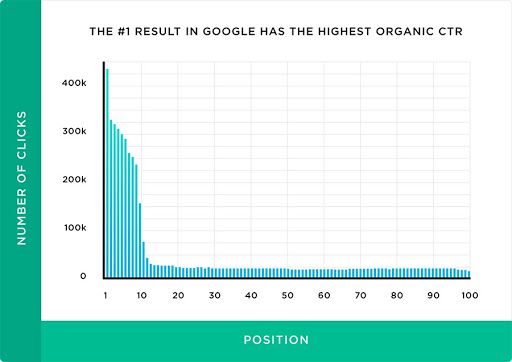
If you’re on page two (or lower) of Google’s search results, you’ll be pretty lucky to get any traffic at all.
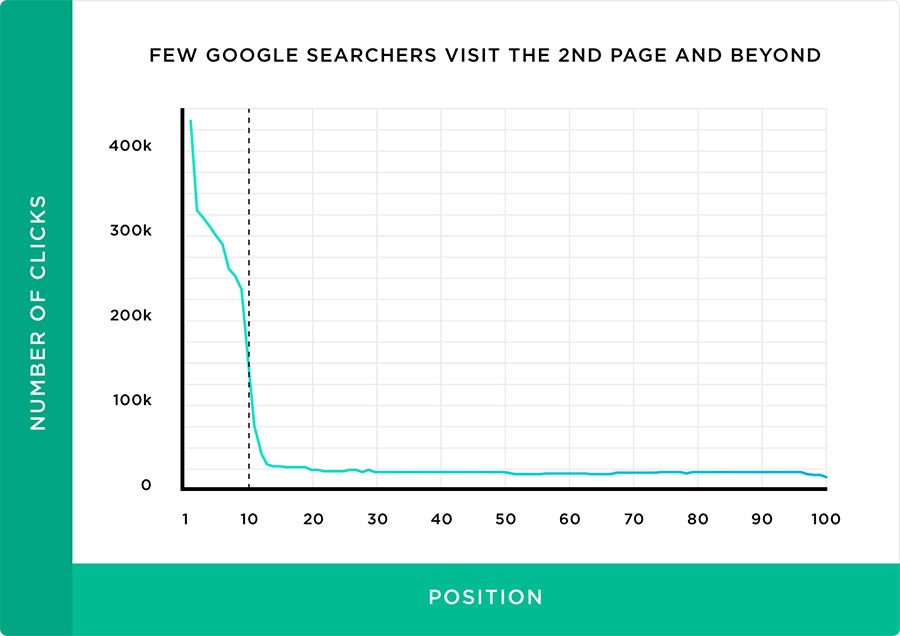
In other words, all sites — regardless of the size of the brand — benefit from investing in SEO.
So SEO matters because:
- It gets you free web traffic (minus your investment in SEO). Who doesn’t want free traffic?
- It’s a long-term investment with long-term benefits.
But there are other, less obvious benefits to SEO.
We take the guesswork (and actual work) out of growing your website traffic with SEO.Search Engine Optimization Made Easy

SEO Helps Your Site (and Brand) Appear More Credible and Trustworthy
A search snippet on the first page of Google essentially acts as an endorsement for your site.
Unsure what a search snippet is?
It’s the summary of a page that appears in the SERPs, typically containing a meta title, meta description, and page URL. In some cases, it can also include things like sitelinks, a sitelinks search box, and information that results from the implementation of structured data, such as pricing and an aggregate review rating.
As an example, here’s the search snippet for our homepage.
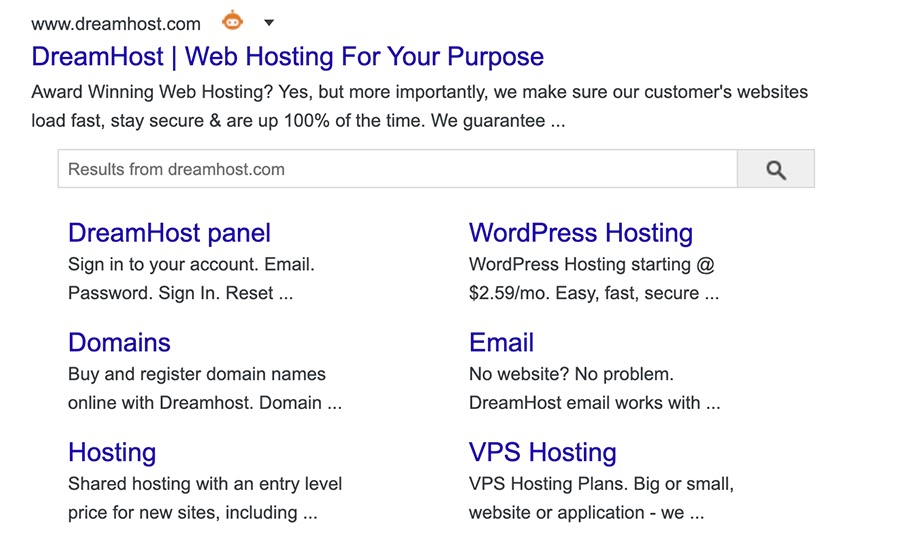
Bear in mind that a search snippet’s appearance can change in accordance with each search. It can also change simply because Google says so.
Google won’t always show your custom title tags or meta descriptions, for example. It will often pull in its own. It doesn’t always display structured data markup, either.
Annoying? Yes.
Avoidable? No.
Regardless…
The simple fact that users are presented with your site when performing a Google search lends it credibility. Bonus points for sites with rich snippets — e.g., snippets that contain some (or all) of the elements mentioned above.
Of course, a first-page ranking isn’t necessarily an endorsement from Google. It’s also no guarantee a site can be trusted. But most users don’t know that. Many simply assume that if Google’s sent them to a website — especially if that site’s on page one of the SERPs — it’s credible and trustworthy.
SEO Provides Your Visitors With Useful and Relevant Information
What’s the number one thing Google (and other search engines) wants?
OK, it’s cold, hard, cash.
But after that?
To serve up the best possible results for all search queries. If Google fails at that, it’ll drive users away and lose revenue.
So what’s this got to do with you, your site, and SEO?
One of the most critical elements of any SEO campaign is content.
If you want to rank well, your site needs interesting, informative, well-presented, and easy-to-understand content. And this doesn’t always mean text. Imagery, video, and audio help enhance pages. They make them more useful for users and, therefore, more likely to appear high up the search results.
In other words, SEO helps create better sites for both search engines and users.
Related: How to Create a Content Marketing Strategy
4 Key SEO Concepts to Understand
Whether you’re talking about Google, Bing, Yandex, or one of the many other search engines out there, they all work in pretty much the same way.
At their simplest, search engines work through a process of crawling and indexing.
It all starts with a web crawler (or spider). In Google’s case, this is Googlebot. Its job is to crawl as many accessible web pages as possible. Each crawler takes a start page and downloads it. Next, it follows any links it finds on that page to another page and then repeats the process.
We’re talking about billions and billions of pages here — and that’s a lot of content. Google itself has gone on record to say their index is well over 100,000,000 gigabytes in size.
1. What Is a Search Engine Index?
Once the crawler has downloaded a page and moved on, it’s added to the search engine’s index. Essentially, this is just a massive data structure.
Every eligible URL that the crawler discovers is kept there, along with key signals about the URL’s contents. This may include, but isn’t limited to:
- Freshness. Is the page new, or is it an old page that’s been updated?
- Keyword phrases and topics. What’s been covered on the page?
- Types of content. Search engines gauge this using formats and schema.
The results are vast amounts of data, which search engines must be able to parse to ensure they’re delivering the best results for the user.
That’s where search engine algorithms come in.
2. What Is a Search Algorithm and How Does It Work?
Over the past 10 years, algorithms have become a part of everyday life — whether we’re aware of them or not.
At the most basic level, scientists have discovered that computers can learn on their own if given a set of instructions. In the past, these were straightforward instructions, but they’ve become increasingly sophisticated over time.
Google’s algorithm updates are a prime example of this.
Google is renowned for tweaking the buttons on its algorithms to help deliver the best results for users. In fact, in 2018, Google reported that it made over 3,000 updates to its algorithms — that’s around nine each day.
You can see a list of all the major Google algorithm updates here.
3. Black Hat SEO vs. White Hat SEO
Since the early days of SEO, there’s been a divide over the best — or most successful, let’s say — search optimization tactics.
Some in the industry divide these into the categories: black hat SEO and white hat SEO (and sometimes grey hat SEO, which falls between the two).
White hat SEO tactics follow Google’s guidelines to a tee. SEOs that use tactics that fall outside of Google’s guidelines are often referred to as Black Hat SEOs (and whose benefits may be deprecated by future algorithm updates).
Here’s a quick — but not exhaustive — list of the tactics used by each group:
White Hat SEO Tactics
- Providing quality content
- Creating web pages for the user; not for search engines
- Making a unique, useful, and engaging website
Black Hat SEO Tactics
- Using link schemes to impact rankings artificially
- Using scraped (or stolen) content
- Implementing doorway pages
- Automatically generating content
- Hiding links or — and this is a very old one — hiding text on pages.
4. On-Page SEO vs. Off-Page SEO
Another way to break down SEO is into the categories on-page SEO and off-page SEO. So what’s the difference?
What Is On-Page SEO?
On-page SEO refers to elements you can change on your website to improve its performance — whether sitewide or for specific pages.
What Is Off-Page SEO?
Off-page SEO refers to factors that aren’t necessarily within your control — meaning, they don’t happen on your website. The most common example of off-page SEO is backlinks (those pointing to your site from other websites).
4 Factors That Affect On-Page SEO
No SEO expert knows all of the factors that make up Google’s (or any search engine’s) algorithms. However, decades of testing and public announcements by Google have revealed some critical practices essential to effective SEO.
1. Content
On-page content helps search engines understand the themes, relevancy, and quality of a page. It also serves users by answering questions about the company, products, or services.
So what should you be considering when writing on-page content? Or creating a content marketing strategy?
Content Quality
This should go without saying, but quality matters — a lot.
Some things to consider when creating quality content include (but aren’t limited to):
- Readability
- Usefulness
- Uniqueness
- Accuracy
Content Freshness
Fresh content helps search engines serve up the most relevant results for a given search query. That’s why, in 2010, Google officially made freshness a ranking factor. The impact of that has been significant, as demonstrated by research from Botify.
Fresh content gets crawled more frequently.
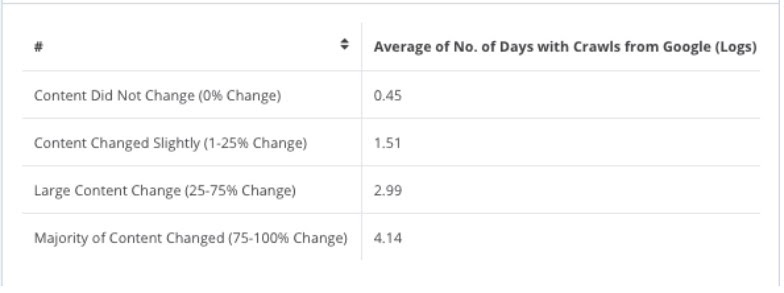
And correlates with higher rankings.
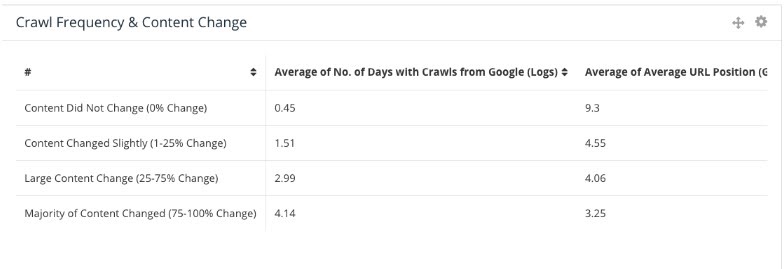
Search Intent
There are four types of search intent:
- Transactional — the user wants to buy something
- Informational — the user wants to research something or find an answer to a question
- Navigational — the user is looking for a specific website
- Commercial research — the user is looking for information to help them decide on a product or service
Search intent changes SERPs. This can make optimization tricky, but it’s not impossible.
Transactional searches will naturally bring up product or service pages. Optimize for them by making your pages better than the competitions’ pages.
Informational queries can be answered with a blog post or similar. Sometimes even an FAQ can suffice.
Commercial queries can be targeted with, for example, pages that compare products or showcase reviews or case studies.
Get the gist?
If not, learn more about search intent here.
Duplicate Content
The best pages — those that search engines want to send users to — are unique pages.
While there’s no actual “penalty” for duplicate content, having it on your site can affect your rankings. In some cases, duplicate content results in affected pages being removed from search engines’ indexes or prevents them from being indexed in the first place.
But how much of a problem is duplicate content, really?
An entire blog post that’s been taken from another site? That’s a problem. Featuring large sections of content from other sites? That’s a problem too.
While you can reproduce others’ content on your site, you should always seek permission and appropriately credit the author with a cross-domain canonical.
That canonical does mean your version of the content won’t rank (or it won’t so long as Google obeys the canonical, which it should when dealing with duplicate content).
But what about duplicate content on your own site? Or handling product descriptions on large e-commerce sites?
This is where things get complicated.
Duplicate content on your site can result in keyword cannibalization — when multiple pages are competing with each other for the same search terms. This makes life hard for search engines. They’ll struggle to decide which page should rank for which term. As a result, no page will rank as high as it would, should you have a single page targeting those competing terms.
Big e-commerce sites can suffer similar problems.
When you have hundreds or even thousands of products, writing a unique description for every product isn’t easy. Often, companies will fall back on using the manufacturer’s descriptions instead.
While Google expects to see some duplicate content on e-commerce sites, odds are you’ll get better results if your descriptions are unique and more detailed than those used on competing sites. Especially when the DA (domain authority) of your website is lower than that of the competition.
For more info on how to handle this type of duplicate content, check out this Whiteboard Friday.
2. Keyword Research
While (most of us) have come a long way since the days of keyword stuffing, keywords are still a big part of on-site SEO.
Simply put, you’re going to get more people to your site if your pages include keywords users are actually searching for.
To discover what these are, you’ll need to do some keyword research. This will help you uncover relevant keywords and tell you how many people (on average) are searching for those keywords, and how competitive they are.
Once that’s complete, you should have enough data to choose keywords that:
- Have a decent search volume
- Have minimal competition, increasing your chances of appearing high up the SERPs
3. HTML
Don’t panic — we’re not going to get into coding websites here. HTML in this context refers to basic optimization that helps boost rankings and click-through-rates. On a CMS like WordPress, you should be able to implement everything described below without touching your site’s code at all.
Title Tags and Meta Descriptions
Earlier, we covered search snippets, which included — amongst other things — a title tag and meta description.

Both your title tag and meta description help “sell” your site. Write them well using copywriting best practices, and you’ll increase the odds of users clicking on your website over a competitor’s.
Title tags are also a ranking factor. The keywords you use in them are likely to get a boost in the SERPs.
That said, don’t use your title tag as an opportunity to ram in primary keywords. Title tags should read naturally and be enticing to users.
Schema
Schema is a collaborative structured data project that helps search engines better understand specific elements of a page, such as pricing, events, or reviews.
When implemented on a web page, schema can enhance your search snippets, and help them stand out from the competition in the SERPs.
For example, here’s a search snippet that includes info on pricing, reviews, platform, and product types.

Learn more about what schema can do and how you can implement them here.
Subheadings
Throughout this article, you can see various subheadings (including the one above that reads “Subheadings”).
Subheadings help users navigate a page. Perhaps more importantly, search engines assign more weight to subheadings than to the text beneath them — so you can use them to help optimize pages.
You might have also noticed the difference in the size of the subheadings. That’s because there are six different subheadings.

A page should only have a single H1 heading (the page title). You can use other subheadings as you see fit, to help structure the text on a page.
4. Site Architecture
The architecture of your site — how internal links are used to structure a website, establish hierarchy, and help search engines and users navigate it — can make or break its organic visibility.
Here are a few things you’ll want to consider when planning or optimizing your site’s architecture (ideally, before your website is built).
Easy-to-Crawl Site
Search engines don’t have an infinite budget. They set crawl limits for sites based on many factors.
Here’s how you can make it easier for search engines to crawl your site.
- No page should be more than four clicks from the home page.
- All navigation links should be clearly marked with descriptive text.
- Avoid “orphan pages” (pages with no internal links to them)
- Ensure you have an XML sitemap and keep it up-to-date
Mobile-Friendliness
This refers to how well your site performs on a mobile device. You need to provide a quality experience regardless of screen size.
Consider that 76% of users shop on mobile devices and that Google has slowly been moving to a mobile-first index over the past few years. This is something you can’t ignore.
So how do you make your site mobile friendly?
- Improve your page speeds (more on this in a moment)
- Build your site using responsive design principles
- Ensure all the elements on your page are “thumb-friendly” and accessible while on a mobile device
- Make sure your font size is legible on mobile devices.
Related: How to Optimize Your Website for Mobile Devices
Page Speed
Can page speed affect your rankings?
Absolutely.
Google has gone on record as saying that all other things being equal, the faster page will rank higher in the search results.
So how do you improve your page speed? Here are some quick tips:
- Reduce redirects
- Optimize images
- Remove render-blocking JavaScript
- Minify CSS, JavaScript, and HTML
- Enable compression
If you want to learn more about implementing these, head over to Google’s documentation on the topic.
Keywords in URLs
Despite being a cornerstone of old-school SEO, the words contained in URLs — supposedly — don’t impact the page’s rankings.
That said there are a few side benefits of having descriptive URLs:
- In the search results, descriptive URLs provide further clues as to the contents of a page. This encourages more click-throughs.
- If people editorially link to your site using a URL, it automatically means you’ll receive some critical anchor text that can potentially improve rankings.
HTTPS and Secure Certificates
In 2014, Google announced that sites with a valid SSL/TLS would benefit from a slight ranking boost, all other things being equal.
If your site still isn’t secure, you’re way behind the times. Talk to your developers. ASAP.
We believe your private data should remain private. That's why we’re proud to offer SSL/TLS certificates from Let’s Encrypt for free.At DreamHost, Security Is on the House

4 Factors That Affect Off-Page SEO
Next up: Off-page SEO can be much trickier to execute than on-page SEO simply because you have far less control over the factors involved. Here’s what you need to consider when actioning off-page SEO.
1. Trust
How much search engines trust your site is a major ranking factor.
A new site with no (or very little) domain and page authority probably isn’t going to rank. At all. If it does, it will be for search terms that few other — or no other — sites are targeting.
As well as DA, PA, and domain age, another off-page ranking factor is your bounce rate.
What’s Bounce Rate?
Bounce rate is the percentage of users that visit one page of a site, then leave.
A high bounce rate isn’t always a bad thing. It could merely mean that a user found what they needed on the first page they landed on. However, if your bounce rate is consistently poor, sitewide, this could be indicative of other problems that ultimately affect your site’s performance in the SERPs.
2. Links
While over time, Google has tweaked its algorithms to make them less reliant on links, they’re still a major ranking factor — if not the most significant ranking factor out there.
Google treats links as a vote of confidence. They also contribute to domain authority, which in turn increases the trust factor associated with your site.
But all links are not created equally.
Good links come from websites that search engines trust. Better links come from websites search engines trust that are also in your niche.
While it’s normal for a site to have some bad links (since you can’t control who links to you), a high percentage of untrustworthy links signals to search engines that your site can’t be trusted.
So aim for a backlink profile that’s dominated by trusted websites. If you’re worried about potentially dangerous links to your site, you can tell Google to discount them via its disavow tool.
Another thing to consider is anchor text.
Natural anchor text (which is what you want) is varied, and rarely includes anything that could be perceived as an actual search term. It will consist of longer phrases that describe the link destination (the page being linked to), the brand name or URL, and phrases like “click here.”
Related: How to Create a Link Building Strategy
3. Social
While (probably) not a direct ranking factor, social media can indirectly increase your search performance.
How?
Primarily because if people are sharing your content socially, they’re more likely to link to it.
A prominent social presence also helps boost brand visibility. This, in turn, can also lead to links and higher click-through rates in the SERPs (another factor that — most likely — affects rankings).
4. Personalized Search
A significant percentage of Google’s search results are personalized — i.e., affected by factors such as the searcher’s location, search history, and the profile Google has built on them.
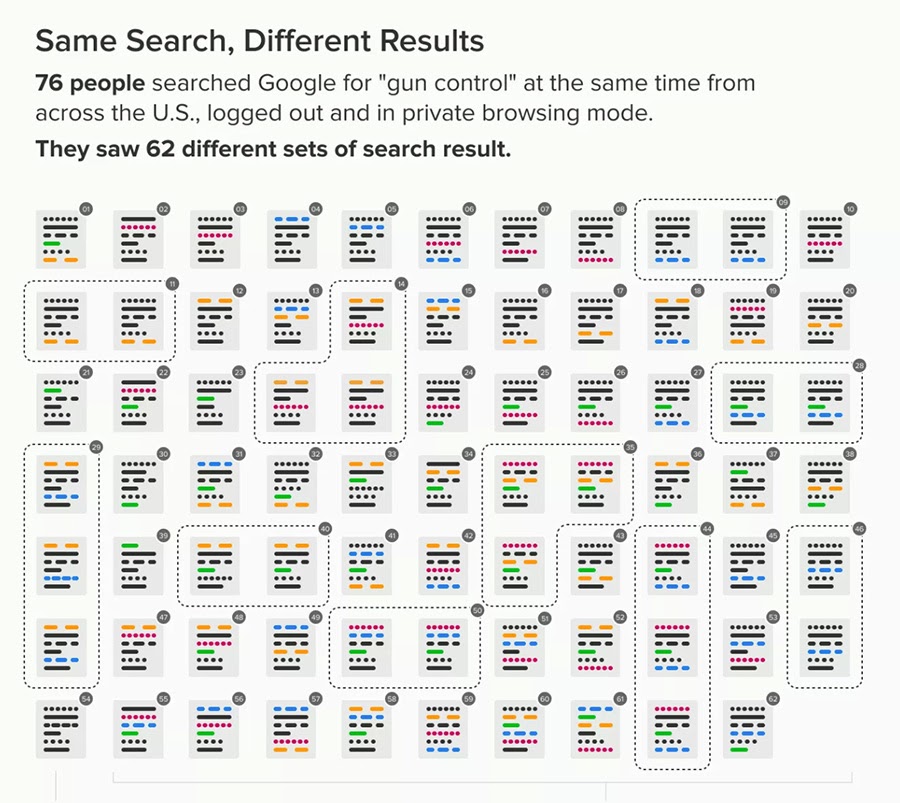
Whether you think this is a useful feature or an invasion of privacy, it’s something anyone wanting to rank on Google needs to consider.
In other words, just because a tool says you rank in position 1 for keywords x, y, and z, that doesn’t mean all searchers will see the same pattern of results.
There isn’t a huge amount you can do regarding personalized search. It’s mostly something you need to consider when measuring results.
That said, if you have a local presence (you have a brick and mortar store or work as a plumber or painter, for example), you can increase visibility in your vicinity (or vicinities) with local SEO.
Related: 12 Marketing Strategies to Promote Your Local Business
An Example SEO Process for Your Website
Before we wrap up, let’s run through what a typical process looks like for implementing and maintaining SEO on your website.
Technical Checks
Checking your site’s technical health can help you unearth issues that could prevent your site from ranking — either as well as it could be, or in some cases, at all.
Keyword Research
Keyword research helps you identify the words and phrases that your target audience is searching for. Quality research will highlight the terms you need to rank for and how competitive they might be.
Content Creation
If you ask people what content creation is, many might say it’s about creating written content. In reality, it’s much broader than that.
Written words — yes, that’s content creation.
Video — that’s also content creation.
As are images, pdfs, whitepapers, podcasts, case studies, infographics, newsletters, presentations, webinars, and . . . you get the idea.
If it’s on your website, it’s content — and it’s something you need to invest in continually.
Title Tag and Meta Description Optimization
These are two cornerstones of SEO.
As mentioned earlier, your title tags let search engines and users know what a specific page is about. As title tags are measured in pixel width, they can change, but a good rule of thumb is to create title tags that are 50-60 characters long.
Meta Descriptions are also part of the HTML and give users a further overview of a page’s content.
This is a handy tool for previewing how your title tags and meta descriptions will look in the SERPs, and whether they fit within the pixel limit.
Off-Page Promotion
While link building is considered the most effective off-page promotion tactic, you can use many other tactics as part of your SEO strategy — especially when you have a smaller budget.
Guest Blogging
Guest blogging has been abused over the years, but it can still promote your site or business. Just stop guest blogging solely for links, and use it instead for qualified traffic or brand awareness.
Forum Posting
Isn’t forum posting outdated and against Google guidelines? Well, not necessarily. Don’t do it to drop links onto sites; instead, use it to build up a steady stream of new traffic and potential customers.
Quora Questions
By offering value on Q&A sites like Quora, you can slowly become seen as an authority in your niche, while also securing valuable backlinks. This lends credence to your website as a go-to resource for users.
Social Media
Despite “evidence” to the contrary, it’s highly unlikely that social media signals are part of Google’s algorithm. That said, done right social media can drive traffic — just make sure you’re not making it all about you. Be helpful. Offer value.
Link Building
To this day, links are still one of the best ways to improve your site’s performance in organic search.
Just beware that search engines (Google in particular) have complicated ways of working out whether these “votes” for your site are natural or not.
So what are the right ways to build links? And what should you avoid?
Link-building tactics to try:
- Link acquisition through content creation
- Outreach to resource pages that could benefit from including your site
- Broken link-building
Tactics you may want to stay away from:
- Article directories
- Unmoderated directories (niche or not)
- User profile signatures
- Over optimized forum signatures
- Paid links
- Low-quality guest blogging
- Link swaps or link exchanges
Improving UX
In May 2020, Google went on record to say that User Experience (UX) would be a vital future ranking factor.
This makes sense. After all, Google has always said your content and site design should be for the user.
But what is UX (or specifically “Page Experience,” as Google calls it), and what can you do to improve it?
Google has rolled several existing ranking factors into its algorithms, alongside its Core Web Vitals, including:
- Mobile-friendliness
- Page speed
- HTTPS ranking boost
- Interstitials penalty
- Safe browsing penalty
Make sure your site incorporates these UX best practices if it doesn’t already.
Conversion Rate Optimization
Many SEO techniques focus on driving organic traffic to your site — but what happens when that traffic gets there?
Enter CRO.
Conversion rate optimization (CRO) is a strategy for increasing revenue or leads from your existing traffic.
CRO involves taking the site you have and testing different page variations to see which converts best. When you reach a statistically significant improvement, you make the winning page your new default.
Like SEO, CRO has no real end. When you’ve completed one test, you move onto the next. Through marginal gains, you’ll improve your UX and convert more visitors into customers.
Whether you need help finding the perfect keyword phrase or writing a meta tag, we can help! Subscribe to our monthly digest so you never miss an article.SEO Advice in Your Inbox

Ready to Get Started?
SEO tools can help with the heavy lifting associated with all of these tactics. Here are a few we recommend for getting the best possible results from your SEO efforts:
Tools for Technical SEO
Tools to Help You Write Better Content
Tools for Keyword Research
SEO Analysis Tools
Want to know more? We’ve published an article on our favorite SEO tools and dug into the most important SEO metrics to track here.
After reading this guide, you know that tackling SEO for your site is a gigantic undertaking. While some people love to DIY their way through hours of SEO work, you don’t have to do that to improve your rankings.
We’ve got you covered!
Our SEO Marketing Service allows you to offload your entire SEO to-do list — including creating fresh, keyword-driven blog posts for your site — to us. We’ve built an incredible team of digital specialists at DreamHost, including SEO strategists, WordPress developers, and content writers — all of whom are standing by to take your site’s organic search performance to the next level.
Learn more about how our SEO Marketing Service can grow your traffic.
